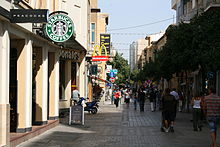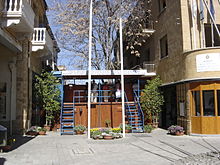Ledra Street
The Ledra Street ( . Greek οδός Λήδρας "Odos Lidras"; . Turk Lokmacı Caddesi ; Engl. Ledra Street ) is a street in the old town of Nicosia and since the occupation of northern Cyprus in 1974 shared.
The longer southern Greek Cypriot part of the street is a busy shopping street with many international chain stores. Its southern end is at the Freiheitsplatz ("Πλατεία Ελευθερίας") on the edge of the ring-shaped walled old town. The much shorter Turkish northern part of Ledrastrasse is separated from the southern part by the 50 meter wide UN buffer zone. Since April 2008 there has been a border crossing for pedestrians between both parts of the city.
history
division
Before independence in 1960, Ledrastrasse was known for a number of years for terrorist acts by the Greek underground movement EOKA against the presence of the English and was therefore referred to as the " Murder Mile ".
After clashes between the Greek and Turkish population groups at the end of 1963, the street was cordoned off for the first time; initially with barbed wire. In 1964 the United Nations sent the UNFICYP peacekeeping force to the island. With the so-called "Green Line" Nicosia was divided in an east-west direction, which also affected the central Ledrastrasse. In the summer of 1974 Turkish troops occupied the northern part of the island; In 1983 the Turkish Republic of Northern Cyprus was proclaimed there. In the following decades Ledra Street became one of the most important symbols for the division of the island.
reopening
In 2003 the Turkish Republic of Northern Cyprus opened its border to the south with initially five crossings. On November 18, 2004, the Republic of Cyprus began unilaterally clearing the mines in the so-called death zone. On December 16, 2004, the Republic of Cyprus informed Northern Cyprus through the United Nations that it wanted to open Ledra Street. The Resolution 1728 of the UN Security Council of 15 December 2006 suggested the opening of more border crossings, "including the Ledra Street" to. On March 9, 2007, in protest, Greek Cypriots destroyed a cement barrier between the southern part of the street and the buffer zone, which was then replaced by an aluminum barrier.
In February 2008 Dimitris Christofias won the presidential elections of the Republic of Cyprus against the conservative incumbent Tassos Papadopoulos . On March 21, 2008, Christofias and the President of the Turkish Republic of Northern Cyprus, Mehmet Ali Talât , announced the opening of the border on Ledra Street.
The border crossing on Ledrastrasse was opened on April 3, 2008 at 9 a.m. local time. The mayor of the Greek-Cypriot southern part of the city, Eleni Mavrou , and the mayor of the Turkish-Cypriot north, Cemal Metin Bulutoğluları , crossed the UN buffer zone together. On the evening of the opening day, the crossing point was closed again by the police of the Republic of Cyprus, as Turkish soldiers had crossed the border in uniform, but after a few hours the border was reopened.
Present meaning
From a symbol of division, the street has become a symbol of unity and is used extensively, albeit mainly by tourists and walkers. Most Cypriots prefer the motorized crossing at other crossings. Before the division, the street was the main shopping street, a role it is unlikely to play due to the greenfield shopping malls. But after opening it is the most popular promenade in the city with numerous coffee houses. Debenhams (formerly Woolworth) department store , which has recently been renovated, is located in the larger shops .
Shaping the transition
The Turkish Republic of Northern Cyprus regards the transfer as entry. Therefore, their side is designed as a border crossing and regularly manned by police officers. Every visitor has to show his passport (or identity card for EU or Turkish citizens) to enter the country, the number is registered and (if a passport is used) an entry stamp valid for 90 days is issued. The Republic of Cyprus does not regard the checkpoint as a border, nor are there any regular controls. Only a small police station was set up in a former shop on Ledrastrasse, from which customs officers set out to randomly check shopping bags, as imports into the customs area of the EU are limited, but many Greek Cypriots use the price differential for cheap shopping.
Individual evidence
- ^ The First Move , Time Magazine , Aug. 27, 1956.
- ^ Parliamentary question by the Cypriot MP Adamos Adamou in the European Parliament, January 17, 2005.
- ↑ Wording of Resolution 1728 ( Memento of the original of December 12, 2013 in the Internet Archive ) Info: The archive link was automatically inserted and has not yet been checked. Please check the original and archive link according to the instructions and then remove this notice. (English).
- ↑ Greek Cypriots dismantle symbol of division , Daily Mail , March 9th of 2007.
- ↑ Roderic Pratt: Ledra closed after just 12 hours ( Memento of the original from April 7, 2008 in the Internet Archive ) Info: The archive link was inserted automatically and has not yet been checked. Please check the original and archive link according to the instructions and then remove this notice. , Famagusta Gazette, April 3, 2008.
- ↑ Symbolic Cyprus crossing reopens , BBC News, 3 April of 2008.
Web links
Coordinates: 35 ° 10 ′ 28 ″ N , 33 ° 21 ′ 41 ″ E



